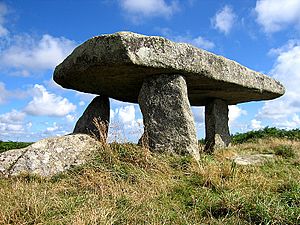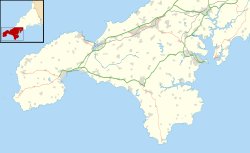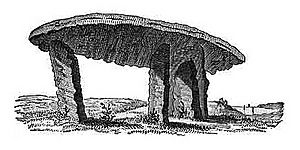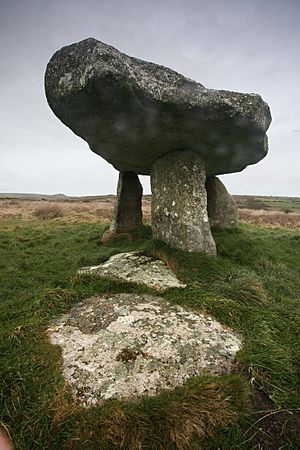Lanyon Quoit facts for kids
 |
|
| Location | Cornwall |
|---|---|
| Coordinates | 50°08′51″N 5°35′57″W / 50.14750°N 5.599167°W |
| Type | Dolmen |
| History | |
| Periods | Neolithic |
| Site notes | |
| Ownership | National Trust |
Lanyon Quoit is an ancient stone structure called a dolmen. You can find it in Cornwall, England, United Kingdom. It is about 2 miles southeast of a village called Morvah.
This amazing monument collapsed during a big storm in 1815. But don't worry, it was put back together nine years later! Because of this, Lanyon Quoit looks quite different today from how it appeared originally.
Contents
Where to Find Lanyon Quoit
Lanyon Quoit is located in the northwest part of Penzance. You can find it on the road that connects Madron and Morvah. The monument stands about 50 metres east of this road.
Not far away, about 700 metres to the west, are the remains of another dolmen. This one is known as West Lanyon Quoit.
What Does Lanyon Quoit Look Like?
Today, Lanyon Quoit has three large stones that stand upright. These stones are about 1.5 metres tall. On top of them rests a huge capstone. This capstone is about 5.5 metres long. It weighs more than 12 tonnes, which is super heavy!
How Lanyon Quoit Changed Over Time
Back in the 1700s, Lanyon Quoit had four supporting stones. It was so tall that a person riding a horse could actually pass underneath it!
But on October 19, 1815, a big storm hit. Lanyon Quoit fell down because of the strong winds. Nine years later, people living nearby raised money to rebuild it. Captain Giddy of the Royal Navy helped guide the rebuilding work.
One of the original stones was too damaged to be put back. That is why today there are only three upright stones. The structure is also not as tall as it used to be. One of the upright stones was turned sideways when it was rebuilt. However, the large capstone is still facing almost the same way it did before the storm.
The Barrow and Other Stones
Lanyon Quoit sits at the northern end of a long barrow. A barrow is like a long, ancient burial mound. This barrow is about 26 metres long and 12 metres wide.
Today, grass and bracken cover the barrow. It is also a bit damaged, so its original shape is hard to see. At the southern end of the barrow, you can find more large stones. These might be the remains of ancient stone boxes called cists.
Learning About Lanyon Quoit
People have been studying Lanyon Quoit for a long time. They want to learn more about its history.
Early Descriptions
In 1769, a person named William Borlase wrote about this amazing stone site. He was the first to describe it in a book. His book included drawings, called etchings. These etchings show Lanyon Quoit looking different from today. This is because his drawings were made before the 1815 storm.
Later, in 1857, another drawing was made by R. T. Pentreath. This etching shows the stones in their current arrangement. A similar drawing also appeared in a book from 1864 by John Thomas Blight.
Further Research and Ownership
In 1872, William Copeland Borlase did more research. He was a descendant of the earlier William Borlase. He even carried out some excavations, which means digging carefully to find old things. He found his ancestor's drawings very helpful. They showed how much the monument had changed over time.
In 1952, the owner of the land, Edward Bolitho, gave the area with Lanyon Quoit to the National Trust. The National Trust is an organization that helps protect special places in England.




